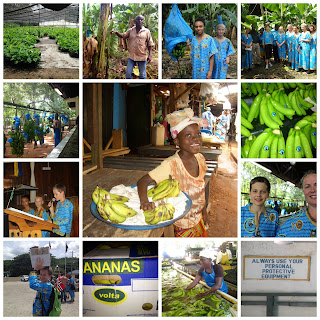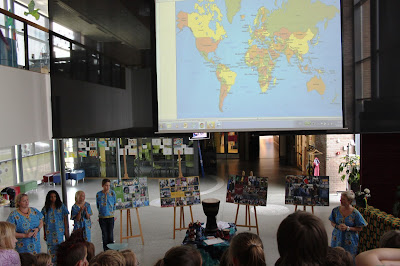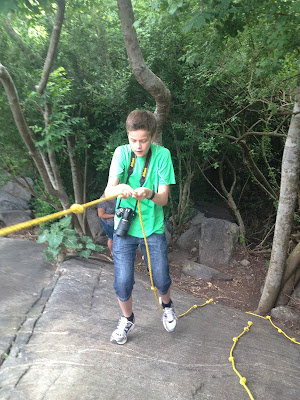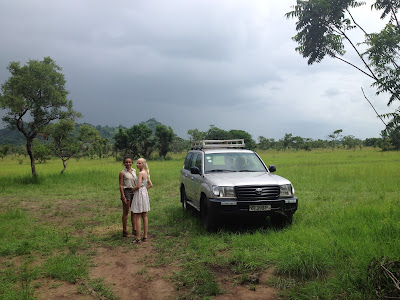Before the journey Ole Magnus wrote this fact related Essay for his English class about Ghana:
Ghana is a Republic in Africa, and it is 238 500 Km2. It lives 24,3 million people in the country, and the population density is 102 each km2. In Norway the population density is 13 each km2. The capital is Accra, and it is located on the south coast. Ghana has 46 different languages but the official one is English. About 60% are Christians, 15% has Islam as their religion and the rest of the populations believe in other religions. The people from the different religion cooperate with each other and maybe that is the reason it is not war in this country.
The national day is the 6th of March and then they sing the national song “Hail the Name of Ghana. The president is John Dramani Mahama. They use Ghanaian cedi and 100 cedi are 294 Norwegian kroner. Ghana borders to Côte d'Ivoire, Burkina Faso and Togo. To the south lies the Gulf of Guinea.
History
The European came to the Ghana coast at the year 1400 and trading companies from many countries build stations there. In 1482 the Portuguese build Elmina-castle in Cape coast and after that the Dutch, English, Swedish and Danish build more stations. The most important merchandise were gold, slaves and ivory. During the 1800 the British get control trough agreements with chiefs, as they wanted to stop the slavery. But Britain just got control over the southern part of Ghana. In 1890 the state in North was independent, but ten years after the British had control over whole Ghana. The name Ghana came from the Ghana Empire and that was close near today’s Mali.
Economy
Ghana is rich in nature resources and has better economy than the neighbor countries in West Africa. The most important exports are gold, cocoa and timber. Most people get their money from agriculture. 40% national products come from agriculture and 60% come from primary industry.
Geography
Ghana is divided into 10 regions: Ashaniti, Brong-Ahafo, Cetral region, Eastern region, Greater Accra, Northern region, Upper East region, Upper West region, Volta region and Western region. The five biggest cities after resident are: Accra (2, 3 million), Kumasi, Tamale, Takoradi and Ashaiman.
The highest mountain is Afadjoto who is 885 meters over sea level. The most normally stone species are slate, sandstone and quartzite. Ghana has a coastline on 550 km. In the south it is hot and moist. In north the weather is affected from desert winds and it is big variations in temperature and rain. In southwest it is a rainforest belt and in south east it is forest mountain areas. In the north it is savannas.
 Volta Lake
Volta Lake
The Volta Lake is one of the biggest human made lakes in the world. It is located behind the Akosombo Dam. The lake is made by the rivers White Volta and Black Volta. The Volta Lake is 520 km long and cover 8 500 km2. The river Volta runs out to Guinea bay and Volta Lake has a rich fish life.
Culture and music
One of the most famous cultural characteristics is the Kent clothes. The clothes are one of the symbols for the Ghanaian leader board and are mainly used by the people group Ashanti. Ghana’s culture is much dancing and singing and they see music as a big part of their life. The music travels from generation to generation so it is not written down. They think it is important that everyone participate in the performance of the music. The songs are often short and the songs repeat themselves often. Rhythm is very important in Ghanaian music and each people group has it owns music. In Ghana they grow up with music and out of the music you can hear where they are coming from.
Highlife
Highlife is Ghana’s most important modern music form. Highlife goes back to brass band and Company band that played in Ghana at the 1920s. Then they used mainly instruments Africans drums, harmonica, guitar and accordion. Now highlife is more based on guitar-based band that plays concert, often with a big scene show. The highlife music has drawn inspiration from Jazz, Blues and traditional African Music and swing.
 Sport
Sport
Football is one of the most popular sports in Ghana. Michael Essien, Derek Boateng and Anthony Annan are some of the best player from Ghana. Other popular sports are athletics, basket and boxing. Ghana has a national game called Oware. Oware is an abstract strategy game of Akan origin. The game requires an oware board and 48 seeds.
The Ashanti people live in south west of Ghana and it is about 1, 5 millions of them. They talk the dialect Twi. Ashanti is considered some one of the richest families in Africa. The Ashanti is world-famous goldsmiths and they are best known in America for their Kent clothes.
Animals
Ghana has a very rich wildlife with elephants, buffalos, antelopes, ground pork, lions, leopards, spotted hyenas, otters and sneak Cats. In Ghana there lives many primates as chimpanzees and vervets. Coastal waters are rich in fish and crustaceans. In the rivers and lakes it lives bikir, lung fish, crocodiles, hippo, crocodile and sea cow. In Ghana it is more than 700 bird species for instance the herons, raptors (including eagles, Red Kite, vultures), birds, turaco, hornbills and kingfishers. Ghana has also many snakes and insects.
Plants
The coastal land is covered by mangrove and coconut trees and large parts of southern Ghana are covered by tropical forest. The central and northern parts of Ghana are covered by savanna, with vegetation consisting of scattered trees and tall grass. 
Food
The food in Ghana is often very spicy. The most traditional foods are Fufu and Banko. Fufu is made of Yam (vegetables) in North and Kassava and Plantain (a type of bananas) in south. It has been beaten, hammered, rammed in a long time until it becomes a ball. The Fufu have been boiled and served with a sauce or soup. Banko is made of corn crushed into powder. Then it must be boiled in water until it becomes like a dough and the dough shall be dipped in the sauce. Food is very cheap and many have their daily work of making and selling food to others. In Ghana they have about the same fruit and vegetables that we have in Norway.
National Day
 The national day is the 6th of March. This year they celebrated that it was 53 years ago Ghana was the first free country in Africa. The celebrations are about the schoolchildren and they march like they do in the military. And there is a competition for the school marching most similar to the military. That national day here you get an extra day off.
The national day is the 6th of March. This year they celebrated that it was 53 years ago Ghana was the first free country in Africa. The celebrations are about the schoolchildren and they march like they do in the military. And there is a competition for the school marching most similar to the military. That national day here you get an extra day off.
Written by Ole Magnus Ryen
Sources






.jpg)































